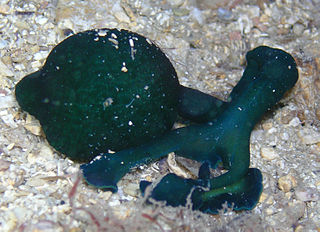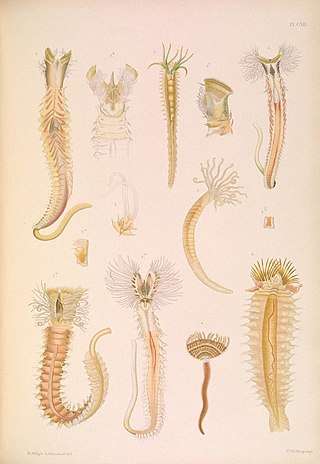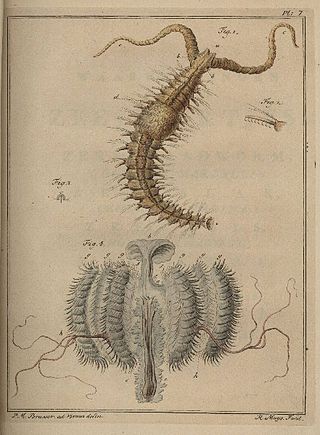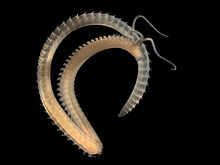
Polychaeta is a paraphyletic class of generally marine annelid worms, commonly called bristle worms or polychaetes. Each body segment has a pair of fleshy protrusions called parapodia that bear many bristles, called chaetae, which are made of chitin. More than 10,000 species are described in this class. Common representatives include the lugworm and the sandworm or clam worm Alitta.

The genus Glycera is a group of polychaetes commonly known as bloodworms. They are typically found on the bottom of shallow marine waters, and some species can grow up to 35 cm (14 in) in length.

Eunicidae is a family of marine polychaetes. The family comprises marine annelids distributed in diverse benthic habitats across Oceania, Europe, South America, North America, Asia and Africa. The Eunicid anatomy typically consists of a pair of appendages near the mouth (mandibles) and complex sets of muscular structures on the head (maxillae) in an eversible pharynx. One of the most conspicuous of the eunicids is the giant, dark-purple, iridescent "Bobbit worm", a bristle worm found at low tide under boulders on southern Australian shores. Its robust, muscular body can be as long as 2 m. Eunicidae jaws are known from as far back as Ordovician sediments. Cultural tradition surrounds Palola worm reproductive cycles in the South Pacific Islands. Eunicidae are economically valuable as bait in both recreational and commercial fishing. Commercial bait-farming of Eunicidae can have adverse ecological impacts. Bait-farming can deplete worm and associated fauna population numbers, damage local intertidal environments and introduce alien species to local aquatic ecosystems.

Alitta virens is an annelid worm that burrows in wet sand and mud. It was first described by biologist Michael Sars in 1835. It is classified as a polychaete in the family Nereididae.

Spirobranchus giganteus, commonly known as the Christmas tree worm, is a tube-building polychaete worm belonging to the family Serpulidae.

Pectinariidae, or the trumpet worms or ice cream cone worms, are a family of marine polychaete worms that build tubes using grains of sand roughly resembling ice cream cones or trumpets. These structures can be up to 5 centimetres (2 in) long. The earliest pectinariid fossils are known from the Cretaceous.

Bonellia viridis, the green spoonworm, is a marine worm noted for displaying exceptional sexual dimorphism and for the biocidal properties of a pigment in its skin.

Ampharetidae are a family of terebellid "bristle worm". As such, they belong to the order Canalipalpata, one of the three main clades of polychaetes. They appear to be most closely related to the peculiar alvinellids (Alvinellidae) which inhabit the deep sea, and somewhat less closely to the well-known trumpet worms (Pectinariidae). These three appear to form one of the main clades of terebellids.

Ampharetinae are a subfamily of terebellid "bristle worm". They are the largest subfamily of the Ampharetidae, of which they contain the great majority of the described genera.

Alitta succinea is a species of marine annelid in the family Nereididae. It has been recorded throughout the North West Atlantic, as well as in the Gulf of Maine and South Africa.

Palpata is a subclass of polychaete worm. Members of this subclass are mostly deposit feeders on marine detritus or filter feeders. Palpata has become superfluous with the elevation of Canalipalpata to subclass.

Spionida is an order of marine polychaete worms in the infraclass Canalipalpata. Spionids are cosmopolitan and live in soft substrates in the littoral or neritic zones.
The Onuphidae are a family of polychaete worms.

Scalibregma inflatum, also known as T headed worm, is a burrowing marine polychaete. It is a cosmopolitan species that can be found from the Arctic to Antarctica, although most probably several species are confounded.

Phyllodoce mucosa is a species of polychaete worm in the family Phyllodocidae. It is found intertidally in both the Pacific and Atlantic Oceans, typically on sandy or muddy seabeds.

Scolelepis squamata is a species of polychaete worm in the family Spionidae. It occurs on the lower shore of coasts on either side of the Atlantic Ocean.

Polydora ciliata is a species of annelid worm in the family Spionidae, commonly known as a bristleworm. It is a burrowing worm and is found in the northeastern Atlantic Ocean and some other parts of the world.
Dipolydora commensalis is a species of polychaete worm in the family Spionidae. It has a commensal relationship with a hermit crab and occurs on the lower shore of coasts on the western side of the Atlantic Ocean.
Polydora glycymerica is a species of annelid worm in the family Spionidae, native to the northwestern Pacific Ocean, where it lives commensally in association with a bivalve mollusc, usually Glycymeris yessoensis but occasionally with another species of clam. The worm intercepts food particles being drawn into the mollusc by its feeding current.

Phyllodoce lineata is a species of polychaete worm in the family Phyllodocidae. It is native to the northeastern Atlantic Ocean and the Mediterranean Sea where it occurs in the intertidal and shallow sub-tidal zones on soft sediment.
















